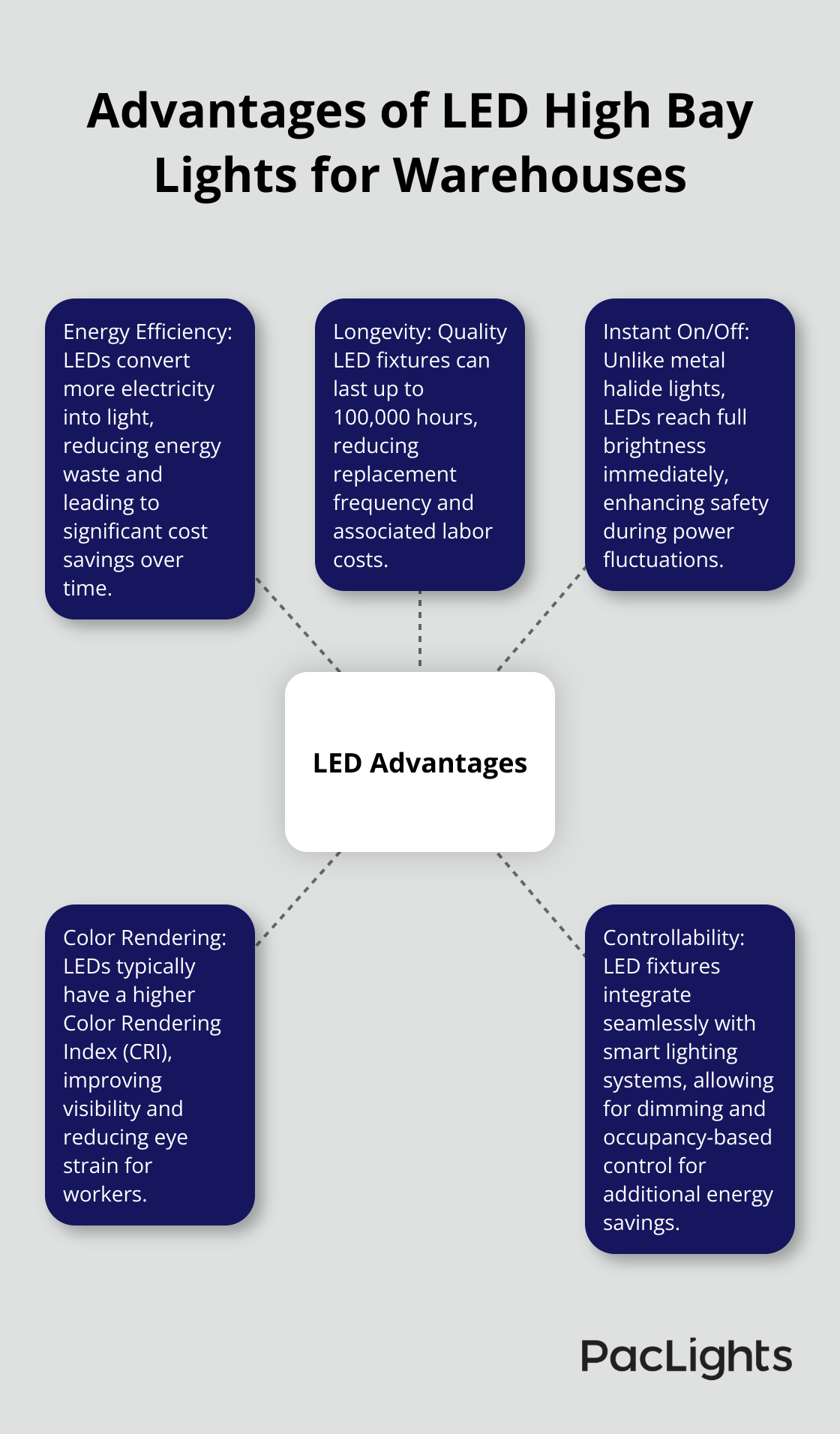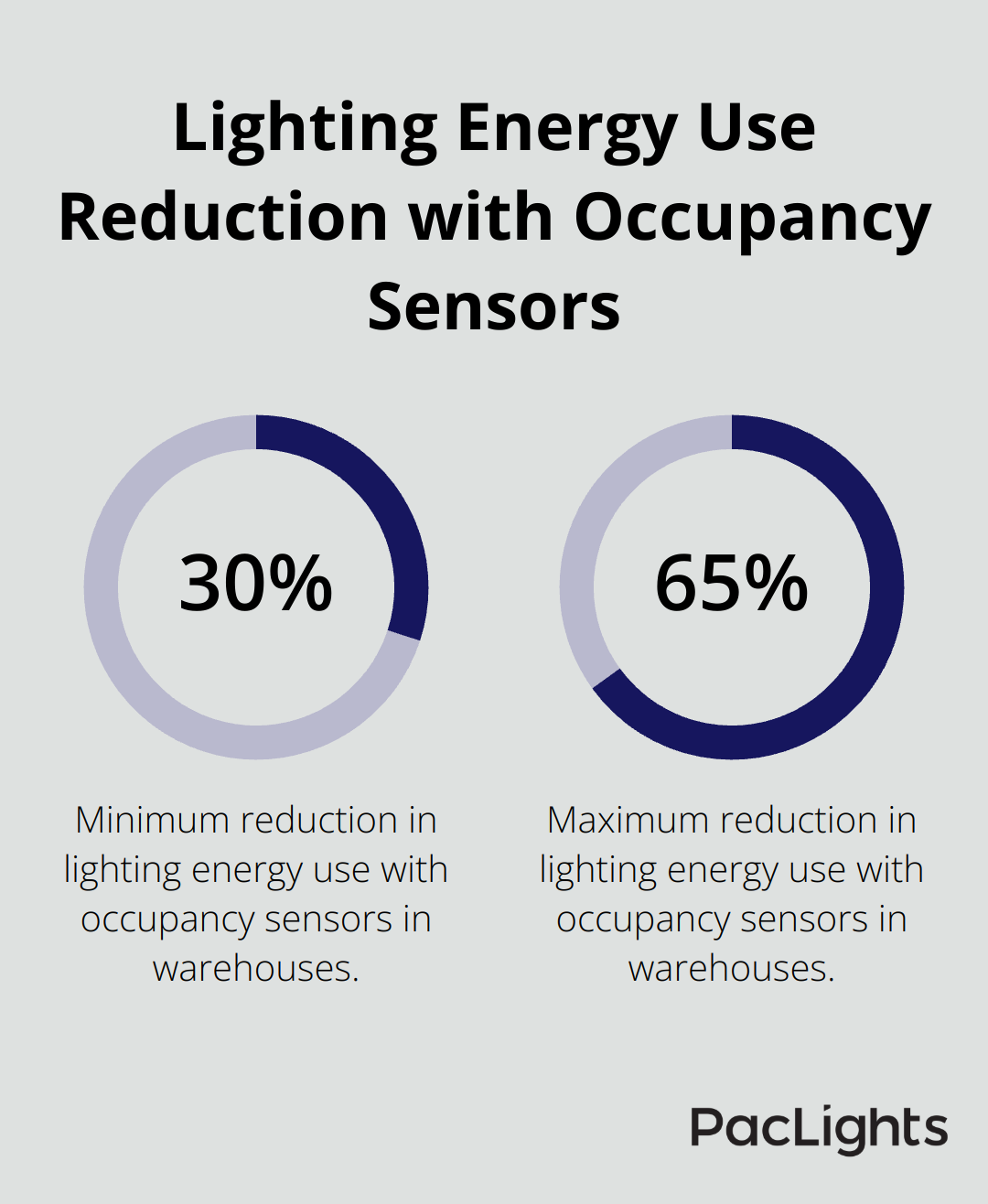Warehouse lighting plays a crucial role in safety, productivity, and energy efficiency. At PacLights, we understand the unique challenges of illuminating large industrial spaces.
Warehouse high bay lights are specifically designed to provide powerful, uniform illumination for areas with high ceilings. In this post, we’ll explore the key features, benefits, and considerations for choosing the right high bay lighting solution for your warehouse.
What Are Warehouse High Bay Lights?
Definition and Purpose
High bay lights are powerful lighting fixtures designed for spaces with high ceilings (typically 20 feet or higher). These lights provide bright, even light distribution across large areas, which is essential for warehouses, manufacturing facilities, and large retail spaces. The main purpose of high bay lighting is to enhance worker safety, boost productivity, and improve overall operational efficiency. In warehouses, proper lighting prevents accidents, enhances inventory management, and allows workers to perform tasks accurately.
High Bay vs. Low Bay Lighting
The primary distinction between high bay and low bay lighting lies in their application:
- High bay lights: Used in spaces with ceilings above 20 feet
- Low bay lights: Suitable for areas with ceilings between 12 to 20 feet
High bay lights feature a more focused beam angle to ensure light reaches the floor from greater heights. In contrast, low bay lights have a wider beam spread for lower ceilings.
Key Features of Warehouse High Bay Lights
- High Lumen Output: These fixtures typically produce between 15,000 to 100,000 lumens, depending on the space’s size and specific needs.
- Energy Efficiency: Modern high bay lights (especially LED models) offer significant energy savings compared to traditional lighting options. A U.S. Department of Energy study found that LED high bay lights can reduce energy consumption by up to 60% compared to metal halide fixtures.
- Long Lifespan: Quality high bay lights can last up to 100,000 hours, which reduces maintenance costs and downtime.
- Heat Management: Effective heat dissipation is important for longevity and performance. Many high bay lights incorporate advanced thermal management systems to prevent overheating.
- Glare Reduction: To minimize eye strain and improve visibility, high bay lights often include anti-glare features or optional glare shields.
- Durability: Warehouse environments can be harsh, so high bay lights are built to withstand dust, humidity, and occasional impacts.

When you select high bay lights for your warehouse, consider factors such as ceiling height, layout, and specific tasks performed in different areas. The right choice of high bay lighting will ensure optimal illumination and energy efficiency for your unique warehouse needs.
Now that we understand the basics of warehouse high bay lights, let’s explore how to choose the right fixtures for your specific requirements.
How to Select the Best High Bay Lights for Your Warehouse
Assessing Your Warehouse Needs
The selection of high bay lights for your warehouse impacts productivity, safety, and energy costs. Start with an accurate measurement of your ceiling height. This determines the required light output and beam angle. A 2019 Illuminating Engineering Society study found that warehouses with 30-foot ceilings typically need fixtures with at least 20,000 lumens for optimal visibility.
Map out your warehouse layout next. Identify areas with different lighting requirements, such as storage aisles, picking zones, and loading docks. A 2021 Logistics Management report revealed that warehouses which tailored their lighting to specific work areas experienced a 12% increase in order accuracy.
Task consideration is essential. High-precision work may require higher light levels. The Occupational Safety and Health Administration (OSHA) recommends a minimum of 10 foot-candles (108 lux) for warehouse aisles and 30 foot-candles (323 lux) for picking and packing areas.
Comparing High Bay Light Technologies
LED high bay lights stand as the top choice for warehouse lighting. They offer superior energy efficiency, longer lifespan, and better light quality compared to traditional options. A 2022 American Council for an Energy-Efficient Economy report found that LED high bays can reduce energy consumption by up to 75% compared to metal halide fixtures.
Metal halide lights, while less efficient, still find use in some warehouses due to their high lumen output. However, they have shorter lifespans (around 15,000 hours) and higher maintenance costs.
Fluorescent high bays offer a middle ground in terms of efficiency and cost. They’re more energy-efficient than metal halide but less so than LEDs. Their main drawback is mercury content, which poses environmental concerns.
The LED Advantage for Warehouses
LED high bay lights excel in warehouse environments for several reasons:
- Energy Efficiency: LEDs convert more electricity into light, which reduces energy waste. This translates to significant cost savings over time.
- Longevity: Quality LED fixtures can last up to 100,000 hours, which reduces replacement frequency and associated labor costs.
- Instant On/Off: Unlike metal halide lights, LEDs reach full brightness immediately. This enhances safety during power fluctuations.
- Color Rendering: LEDs typically have a higher Color Rendering Index (CRI). This improves visibility and reduces eye strain for workers.
- Controllability: LED fixtures integrate seamlessly with smart lighting systems. This allows for dimming and occupancy-based control. The DesignLights Consortium reports that such controls can add another 30-50% in energy savings on top of the LED upgrade.

When you select LED high bays, pay attention to the fixture’s efficacy (lumens per watt). Top-performing models now exceed 200 lumens per watt, which maximizes energy savings.
The right high bay lighting solution transforms your warehouse operations. The next section explores how to optimize your lighting setup for maximum efficiency and effectiveness.
How to Optimize Warehouse Lighting
Strategic Fixture Placement
Proper placement of high bay lights maximizes warehouse efficiency. The Illuminating Engineering Society recommends a spacing-to-mounting-height ratio of 1 to 1.5 for most warehouses. This means if your fixtures are mounted at 30 feet, they should be spaced 30 to 45 feet apart. However, this can vary based on the specific light output and beam angle of your chosen fixtures.
Focus on high-traffic areas and workstations first. These zones typically require higher light levels. The U.S. Department of Energy suggests 30-50 foot-candles for general warehouse areas and up to 100 foot-candles for detailed work areas. Use light meters to measure current levels and identify areas that need improvement.
Aisle lighting requires special attention. Mount fixtures directly above aisles to minimize shadows on shelves. This improves visibility for order picking and reduces errors. A study by the Lighting Research Center found that proper aisle lighting can increase order accuracy by up to 15%.
Leveraging Lighting Controls
Smart lighting controls significantly boost energy efficiency. Occupancy sensors are particularly effective in warehouses. They can reduce lighting energy use by 30-65% (according to the National Electrical Manufacturers Association). Install these sensors at the ends of aisles and in less frequently used areas.

Daylight harvesting systems adjust artificial light levels based on available natural light. This is especially useful in warehouses with skylights or large windows. The DesignLights Consortium reports that daylight harvesting can lead to additional energy savings of 20-60%.
Tackling Common Lighting Challenges
Glare is a frequent issue in warehouses, particularly with high bay lights. It can cause eye strain and reduce productivity. To combat this, choose fixtures with lower glare ratings or use glare shields. Some facilities have seen a 10% increase in worker comfort after addressing glare issues.
Uniformity is another critical factor. Uneven lighting can create dark spots and shadows, leading to safety hazards. Try to achieve a uniformity ratio (minimum to average light levels) of at least 0.7 for general areas and 0.5 for aisles. This ensures consistent visibility throughout the space.
Color temperature also plays a role in warehouse lighting. Cooler temperatures (5000K-6500K) can enhance alertness and are often preferred for task-oriented areas. However, warmer temperatures (3000K-4000K) may be more comfortable for break rooms or offices within the warehouse.
Final Thoughts
Warehouse high bay lights play a vital role in creating safe, productive, and energy-efficient industrial spaces. Warehouse managers who understand the key features of these fixtures can make informed lighting decisions that positively impact operations. The shift towards LED technology in high bay lighting has revolutionized warehouse illumination, offering superior energy efficiency, longevity, and light quality compared to traditional options.
Optimizing warehouse lighting extends beyond selecting the right fixtures. Strategic placement, smart controls, and addressing common challenges like glare and uniformity maximize the benefits of high bay lighting. These considerations enhance safety and productivity while contributing to substantial energy savings (up to 75% with LED fixtures).
We at PacLights understand the unique lighting needs of warehouses and industrial facilities. Our range of high bay lighting solutions meets the diverse requirements of modern warehouses. We offer energy-efficient LED fixtures that can be customized with optional daylight and motion controls, as well as advanced lighting control systems for further optimization.


Disclaimer: PacLights is not responsible for any actions taken based on the suggestions and information provided in this article, and readers should consult local building and electrical codes for proper guidance.